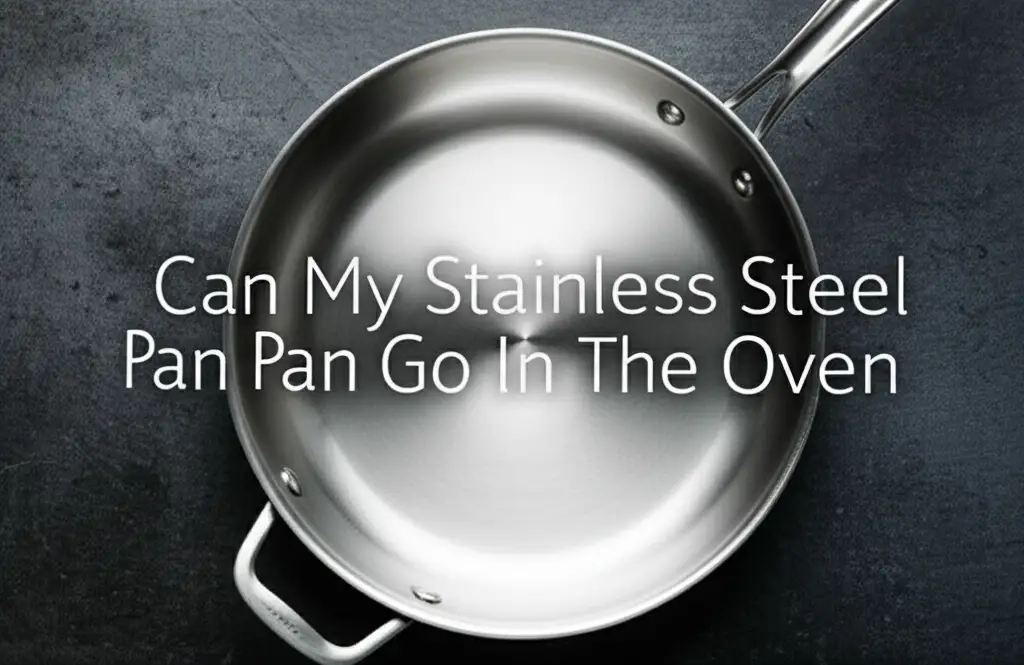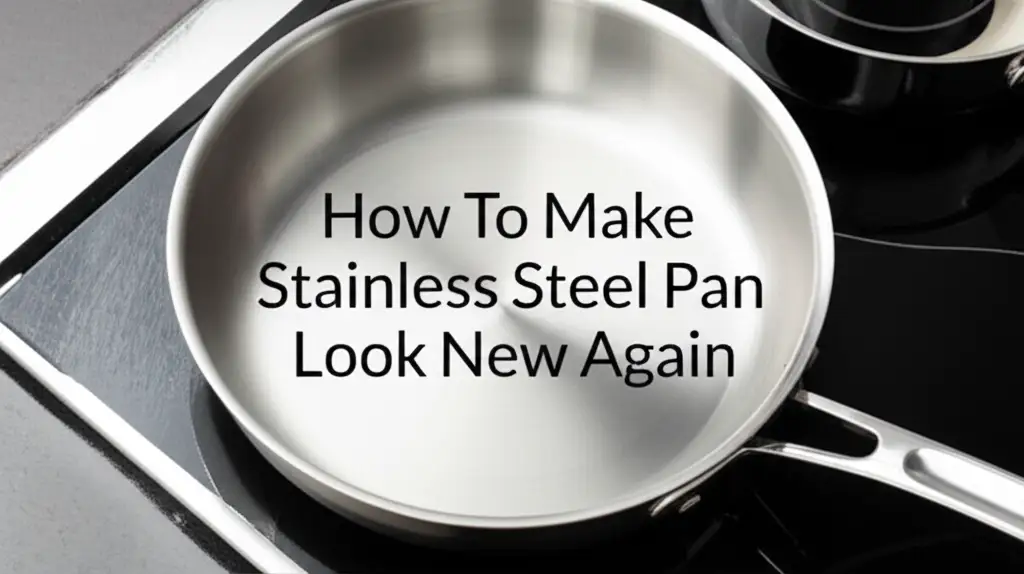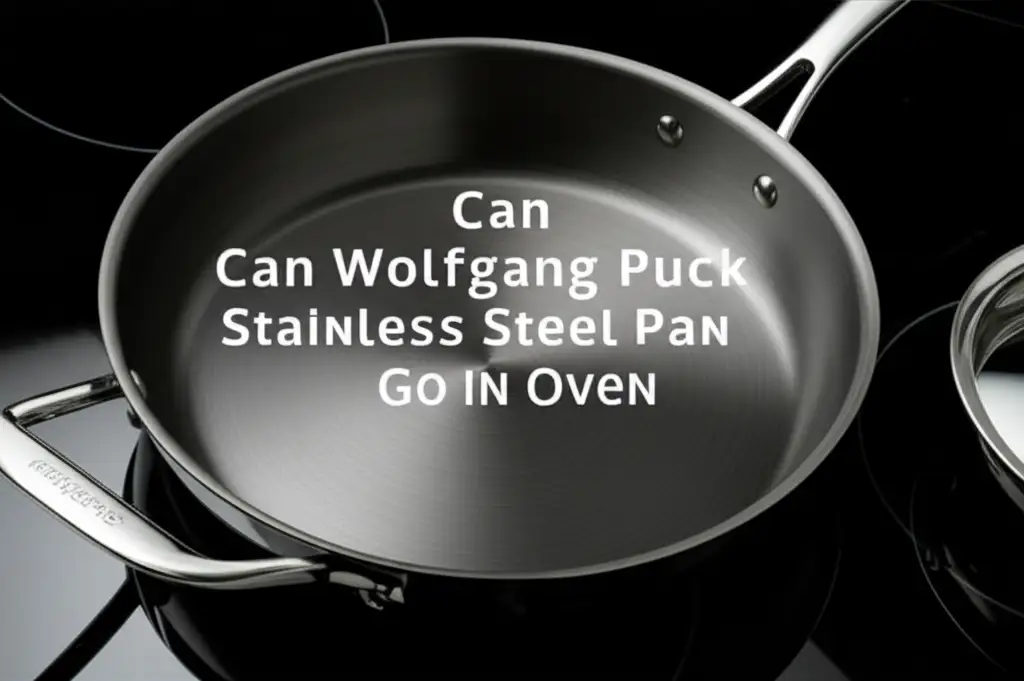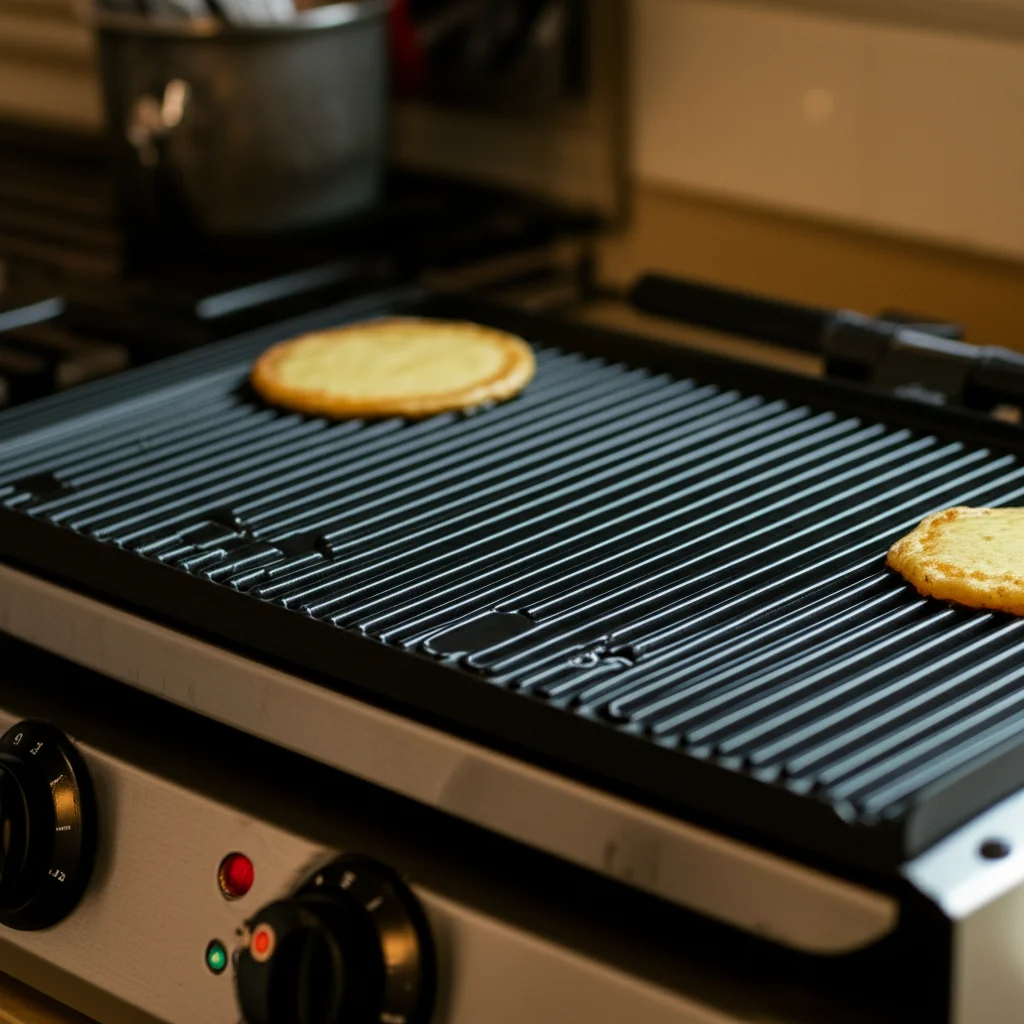· Katria Melrose · Cookware Guides · 14 min read
Can My Stainless Steel Pan Go In The Oven

Can My Stainless Steel Pan Go In The Oven?
Stepping into the kitchen, you might often wonder about your tools. We all love our stainless steel pans for stovetop cooking. But what happens when a recipe calls for oven time? The big question is: can my stainless steel pan go in the oven? Many home cooks face this uncertainty. Understanding your cookware’s limits keeps your kitchen safe and your food perfectly cooked. This guide helps you identify oven-safe stainless steel. We will explore key features, temperature ratings, and proper usage. You will learn how to use your stainless steel pans safely in the oven.
Takeaway
- Check Manufacturer’s Instructions: Always look for oven-safe symbols or temperature limits.
- Inspect All Components: Ensure handles, lids, and any coatings are oven-safe.
- Mind Temperature Limits: Do not exceed the pan’s stated maximum temperature.
- Avoid Thermal Shock: Let pans cool gradually before washing.
Yes, your stainless steel pan can likely go in the oven. Most stainless steel pans are oven-safe. However, confirm that all parts, like handles and lids, are made from oven-safe materials. Always check the manufacturer’s maximum temperature rating.
Understanding Stainless Steel: Is It Oven-Safe?
Stainless steel is a popular choice for cookware. It is known for its durability and even heating. The material itself, stainless steel, has a high melting point. This means the metal part of your pan can withstand very high oven temperatures. This makes it an ideal material for oven use. Many chefs rely on stainless steel for recipes that start on the stove and finish in the oven.
However, the pan is more than just its steel body. A pan includes handles, lids, and sometimes a non-stick coating. These components determine if the entire pan is oven-safe. Some handles are made of plastic or wood. These materials will melt or burn in the oven. Glass lids may also not withstand high heat. You must check every part of your pan.
Identifying an oven-safe stainless steel pan is simple. Look for clear markings on the pan or its packaging. Manufacturers often print symbols or maximum temperature ratings. If you still have the box, check the use and care instructions. This information helps you use your pan correctly. Always prioritize safety in the kitchen.
Key Components Affecting Oven Safety
When you ask, “Can my stainless steel pan go in the oven?”, you need to consider all its parts. The pan’s body is typically fine. However, other components can melt, crack, or release harmful fumes. Understanding these parts is crucial. You want to make sure your pan handles the heat.
Handles and Knobs: This is the most common concern.
- Metal Handles: Handles made from stainless steel, cast iron, or aluminum are usually oven-safe. They conduct heat, so always use oven mitts. Some brands, like Cuisinart stainless steel pans, often feature oven-safe metal handles.
- Silicone Handles: Silicone can withstand high temperatures, but check the specific rating. Most silicone is safe up to 400-500°F (200-260°C).
- Plastic or Bakelite Handles: These are rarely oven-safe. They will melt or degrade at oven temperatures. Avoid putting pans with these handles in the oven unless specified.
- Wooden Handles: Wood will burn or dry out in the oven. These pans are not suitable for oven use. You might find removable wooden handles on some pans. If so, remove them before baking.
Lids: Lids also have temperature limits.
- Glass Lids: Tempered glass lids are common. They are often oven-safe up to certain temperatures, usually around 350-400°F (175-200°C). Exceeding this can cause them to shatter.
- Metal Lids: Stainless steel or cast iron lids are generally oven-safe to the same temperature as the pan itself.
- Plastic Knobs on Lids: Just like pan handles, plastic knobs on lids will melt. Ensure they are metal or high-heat silicone.
Non-stick Coatings: While less common on pure stainless steel, some pans may have a coating.
- Traditional non-stick coatings are usually not oven-safe above 500°F (260°C). High heat can damage the coating. It can also release fumes. Always check if your pan has a coating and its temperature limit. Most true stainless steel pans do not have non-stick coatings. If you need to make your stainless steel pan less sticky, consider proper preheating and oiling methods. You can learn more about how to get your stainless steel pan to not stick for stovetop use.
Identifying Oven-Safe Stainless Steel Pans
Knowing if your stainless steel pan is oven-safe saves time and prevents damage. You do not want to ruin your pan or your meal. There are clear indicators to look for. Always make checking a habit before you place any cookware into a hot oven.
First, check the bottom of the pan. Many manufacturers print oven-safe symbols or temperature ratings there. These symbols look like an oven icon or include a number with a degree sign (°F or °C). If you see “oven-safe up to 500°F,” you know its limit. Some brands, like Wolfgang Puck stainless steel pans, often provide this information.
Next, consider the pan’s design. Pans designed for oven use often have all-metal construction. This includes the body and the handles. Riveted metal handles are a good sign. If the pan has plastic, wood, or silicone components, verify their specific temperature rating. If a pan has removable handles, confirm you can remove them before oven use.
If you cannot find a marking on the pan, check the original packaging or the manufacturer’s website. A quick search for your pan’s brand and model number can provide the answer. It is always best to be sure. Never guess with oven safety. Using the right information prevents accidents.
Temperature Limits: How Hot Can Your Stainless Steel Pan Go?
Understanding temperature limits is vital for oven safety. Stainless steel itself can withstand extremely high heat. However, the other parts of your pan have lower tolerance. This is why a pan’s overall oven-safe temperature is often lower than the steel’s melting point.
Most stainless steel pans, if fully metal, are oven-safe up to 500°F (260°C). Some high-quality pans can even go up to 600°F (315°C) or higher. Pans with silicone handles or glass lids usually have lower limits, around 350-450°F (175-230°C). Always respect these specific limits. Exceeding them can damage the pan or its components. It can also pose a safety risk.
Thermal shock is another important consideration. This happens when a pan experiences a sudden, drastic temperature change. For example, moving a hot pan directly into cold water can cause warping or cracking. This is especially true for glass lids. Always let your stainless steel pan cool down gradually after taking it out of the oven. Avoid placing a hot pan on a cold, wet surface. Rapid cooling can cause stress on the metal. If you want to know how to tell if stainless steel pan is hot enough for stovetop cooking, remember oven temperatures work differently. You set the oven, and the pan slowly heats to that temperature. Once out of the oven, handle with care.
Best Practices for Using Stainless Steel Pans in the Oven
Using your stainless steel pan in the oven expands your cooking possibilities. You can roast vegetables, bake casseroles, or finish seared meats. Following best practices ensures great results and keeps your pan in top condition. Proper use also extends the life of your cookware.
- Preheat Safely: Do not put a cold stainless steel pan directly into a very hot oven without any contents. While stainless steel is durable, preheating with food inside helps distribute heat evenly. It also reduces thermal shock. You can preheat the pan briefly on the stovetop first if the recipe calls for it.
- Use Oven Mitts: Stainless steel conducts heat. Pan handles will become extremely hot in the oven. Always use heavy-duty oven mitts or pot holders when handling the pan. Be careful even after taking it out; it retains heat for a long time.
- Avoid Broiler Use Without Caution: Some stainless steel pans can go under the broiler, but check the manufacturer’s guidance. Broilers provide intense, direct heat. This heat can be much higher than the general oven temperature. Ensure the pan’s components are rated for such extreme heat. The risk of damaging handles or non-stick coatings increases under a broiler.
- Clean Properly After Oven Use: Food baked onto a pan can be stubborn. Allow the pan to cool completely before cleaning. Soaking it in warm soapy water helps loosen baked-on bits. For tougher stains, you might need stronger cleaning methods. Learn about how to clean stainless steel for general care. For particularly stubborn burnt food or oil, methods like how to clean burnt oil from stainless steel pan can be useful.
Remember these steps for safe and effective oven cooking. Your stainless steel pan is a versatile tool. Use it well to create delicious dishes.
Common Mistakes to Avoid When Baking with Stainless Steel
Using stainless steel pans in the oven can be simple, but some common mistakes can lead to problems. Avoiding these ensures your pan lasts longer and your food cooks perfectly. I have made some of these mistakes myself, so learning from them is key.
- Ignoring Temperature Limits: The biggest mistake is putting a pan in the oven above its rated temperature. This applies especially to handles and lids. Plastic handles will melt. Glass lids can shatter. Always check the maximum safe temperature. A pan rated for 350°F should not go into a 450°F oven.
- Using Pans with Non-Oven-Safe Components: If your pan has wooden handles, do not put it in the oven. The wood will burn or crack. Similarly, soft plastic knobs or handles are not oven-friendly. These components indicate the pan is for stovetop use only.
- Submerging a Hot Pan in Cold Water: This causes thermal shock. A hot pan taken from the oven must cool down gradually. Putting it straight into a sink of cold water can cause the metal to warp or crack. This ruins the pan’s flat bottom. It also creates a loud, alarming sound. Wait for the pan to reach room temperature before washing it.
- Leaving Food Burnt On: Baked-on food, especially from high-temperature roasting, can be tough to clean. Leaving it on for too long makes cleaning harder. Always clean your pan as soon as it cools. This prevents long-term staining and residue build-up. You can find tips on how to clean stainless steel pan from burnt oil to restore its shine.
- Using Abrasive Cleaners on All Finishes: While stainless steel is durable, some pans have polished exteriors. Harsh scrubbing pads or abrasive cleaners can scratch these finishes. Use appropriate cleaners and soft sponges for regular cleaning. For tough stains, you can use methods like baking soda. You can learn about how to clean stainless steel pan with baking soda for effective cleaning.
By avoiding these pitfalls, you can use your stainless steel pans safely and effectively in the oven for many years.
Benefits of Using Stainless Steel Cookware in the Oven
Using your stainless steel pan in the oven offers many advantages. This cookware is incredibly versatile. It moves seamlessly from stovetop to oven. This ability makes it a favorite for many chefs and home cooks. I find it especially useful for dishes that need a quick sear and then slow roasting.
One major benefit is durability. Stainless steel is tough. It resists dents, scratches, and corrosion. This means your pan can handle the high heat of the oven without deforming. It stands up to repeated use over time. You will not need to replace it often.
Another plus is even heat distribution. Stainless steel often has an aluminum or copper core. This layered construction helps heat spread uniformly across the pan. This prevents hot spots. Even heating leads to food that cooks thoroughly and browns beautifully. Your roasted chicken will cook evenly from all sides.
Stainless steel is also non-reactive. Unlike some other metals, it does not react with acidic foods. This means your tomato sauce or lemon chicken will taste pure. There is no metallic flavor transfer. This is a great feature for baking dishes with acidic ingredients.
Finally, stainless steel is easy to clean and maintain. After oven use, most stainless steel pans clean up well. They can often go into the dishwasher if they are fully oven-safe. You can learn more about can I put my stainless steel pan in the dishwasher for cleaning options. For stubborn stains, simple home remedies work wonders. You can keep your pans looking great for years. These benefits make stainless steel a valuable part of any kitchen.
Caring for Your Oven-Safe Stainless Steel Pans
Proper care ensures your oven-safe stainless steel pans last a long time. They are investments. Good care keeps them performing well and looking good. I have found that a little effort goes a long way.
First, always allow the pan to cool completely after oven use. Never put a hot pan into cold water. This prevents thermal shock, which can warp the pan. Once cool, you can begin cleaning.
For most messes, warm water, dish soap, and a soft sponge work well. If food is stuck, soak the pan for a while. This loosens baked-on bits. For tougher stains or discoloration, common kitchen items work. Baking soda and a little water create a paste for gentle scrubbing. Vinegar can also remove water spots or mild discoloration. You can learn about how to clean stains on stainless steel for various issues.
To keep the pan shiny, dry it immediately after washing. Air drying can leave water spots, especially in hard water areas. A soft cloth prevents these marks. For a truly renewed look, occasionally polish your pan. You can find tips on how to make stainless steel pan look new again.
Store your pans carefully. Avoid stacking them directly without protection. This can cause scratches. Place a cloth or paper towel between stacked pans. This simple step keeps their surfaces smooth. By following these care steps, your stainless steel pans will remain reliable for both stovetop and oven cooking.
FAQ Section
Q1: How do I know if my stainless steel pan is oven safe? A1: Look for markings on the pan’s bottom or handles. An oven-safe symbol or a temperature rating indicates it is safe. If no markings are present, check the manufacturer’s website or product manual. Pans with all-metal construction are generally a good sign of oven safety.
Q2: Can I put a stainless steel pan with a plastic handle in the oven? A2: No, you should not put a stainless steel pan with a plastic handle in the oven. Plastic handles will melt or warp at oven temperatures. This can damage the pan and create a safety hazard. Always ensure all components are oven-safe.
Q3: What is the maximum temperature for a stainless steel pan in the oven? A3: The maximum temperature varies by pan. Fully metal stainless steel pans are often safe up to 500°F (260°C) or more. Pans with glass lids or silicone handles have lower limits, typically 350-450°F (175-230°C). Always check your specific pan’s rating.
Q4: Can a hot stainless steel pan go from the oven to water? A4: No, avoid putting a hot stainless steel pan directly into cold water. This sudden temperature change causes thermal shock. Thermal shock can warp or crack the pan. Always let the pan cool down slowly on a heat-safe surface before washing.
Q5: Will putting my stainless steel pan in the oven ruin it? A5: No, using an oven-safe stainless steel pan in the oven will not ruin it. If you follow the manufacturer’s temperature guidelines and avoid thermal shock, your pan will perform well. Pans with non-oven-safe parts or misuse can suffer damage.
Conclusion
So, can your stainless steel pan go in the oven? For many, the answer is a resounding yes. Most stainless steel cookware is designed to withstand oven temperatures. This makes it incredibly versatile for various cooking methods. From searing meats on the stove to finishing them in the oven, your stainless steel pan can be a true workhorse.
Remember to always check your specific pan’s features. Pay close attention to handles, lids, and any non-stick coatings. These components dictate the pan’s overall oven safety and temperature limits. Knowing your pan’s limits prevents damage and ensures safe cooking. By following proper care and usage guidelines, your stainless steel pan will serve you well for many years. Embrace the full potential of your stainless steel cookware. Get ready to cook amazing meals that move effortlessly from stovetop to oven.





